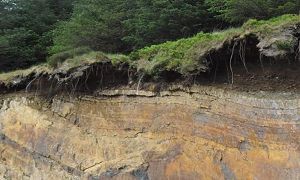ARCHIVED CONTENT: In December 2020, the CZO program was succeeded by the Critical Zone Collaborative Network (CZ Net)
×
CZ Science 6. Geochemistry & biogeochemistry
A Pennsylvania cliff, illustrating a cross section of the Critical Zone with trees, soil, and bedrock.
This module examines the integrated roles that biology, geology, and chemistry play in the CZ. Use data from real world systems to understand how the CZ is involved in key biogeochemical functions. This module is part of a undergraduate course on CZ Science hosted by InTeGrate SERC.
Grades 15 -
16
Geochemistry/Mineralogy • Biogeochemistry
Curriculum
Educational Objectives
By the end of this module students will be able to:
- Develop a scientific and geoscientific habit of mind through biogeochemical-based activities.
- Evaluate the chemical and biological processes and reactions that govern the composition of the CZ.
- Explain the role of CZ services in supporting terrestrial life, including humanity.
- Explain and use examples of how organisms and biodiversity affect biogeochemical processes.
- Use data, and examples from published scientific literature to explain critical zone functions.
- Explain some of the common methods used in biogeochemical research.
- Explain the effect of differences in land-use on nutrient cycling and critical zone functions.
More on this module's objectives can be found here.
Audience
Higher Education
Observatory: National CZO
Author(s): Adam Hoffman (University of Dubuque) and Adam Wymore (University of New Hampshire)
Funding: National Science Foundation–funded SERC InTeGrate project
Related Resource(s):
- CZ Science 0. Undergrad course (7 modules)
- CZ Science 1. Critical Zone background
- CZ Science 2. Methods of Critical Zone Science
- CZ Science 3. Critical Zone architecture & evolution
- CZ Science 4. Land-atmosphere exchange
- CZ Science 5. Water transfer through the Critical Zone
- CZ Science 7. Humans in the Critical Zone
Details for this Resource
Instructors should note that this section primarily focuses on the carbon, nitrogen, and phosphorous cycles with a smaller emphasis placed on the sulfur cycle.
- Unit 6.1: Biogeochemical Modeling Framework - Biogeochemistry: Inputs and transformation (Three 75 min class sessions)
- Unit 6.2: Biogeochemical Examples - Geochemistry: Phosphorus and eutrophication (Two 75 min class sessions)
Explore Further


